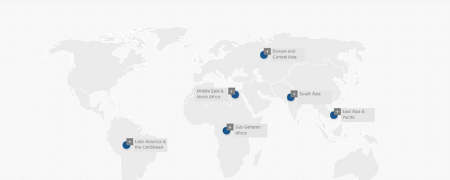Building the ecosystem
The mobile money industry continues to expand globally, with more than 270 live mobile money deployments in 90 countries and an increasing number of deployments at scale: 30 deployments have at least one million active mobile money customers. In addition, there are 19 markets with more mobile money accounts than bank accounts, indicating that mobile money remains a key enabler of financial inclusion.
However, mobile money usage continues to be dominated by two use cases: person-to-person (P2P) transfers and airtime top-ups. To increase sustainability, mobile money providers are exploring new models and products – such as account-to-account (A2A) interoperability, international remittances, merchant payments, salary disbursements and government-to-person (G2P) transfers – but the volumes and values of these represent only a minority of overall transactions.

Mobile Money Metrics

Launching the GSMA Inclusive Tech Lab

GSMA Mobile Money API

International Remittances
Greater progress on financial inclusion and the creation of a successful mobile money ecosystem can only be achieved by developing use cases beyond transfers and airtime top-ups. Embracing the mobile money ecosystem brings major benefits to customers and to providers:
- More services for customers which better address their financial needs: With new services being enabled via mobile money, new customer segments will be served (e.g. women, or farmers). Mobile money enables cost-efficient, secure and reliable payments to and from financially excluded and underserved populations.
- Increased profitability for providers: Deployments that build a mature ecosystem can expect healthy profit margins of more than 20% and cash flow margins in excess of 15%.
E-Commerce
In emerging markets, increasing smartphone adoption and growing internet penetration is fuelling the expansion of e-commerce. The Asia Pacific region is expected to grow from US$ 1.4 trillion to $3.0 trillion. While Sub-Saharan Africa currently represents a smaller market, e-commerce sales are projected to reach US$75 billion by 2025. E-commerce has become a significant tool in unlocking job creation and innovation for small and medium-sized enterprises (SMEs) in developing countries.
The World Bank’s Global Findex database shows that in key mobile money markets, e-commerce is being used by low-income and rural communities. However, in these markets, over 70 per cent of e-commerce payments involve cash-on-delivery payment processes which are expensive, inefficient and time-consuming for both merchants and buyers.In markets where e-commerce is already established, mobile money could become a key enabler of e-commerce payments. Additionally, mobile money adoption could be driven by e-commerce payments in other regions, such as Southeast Asia, where there are opportunities for significant mobile money growth.
The GSMA Mobile Money programme has been supporting operators in digitising e-commerce payments through demand-driven research and sharing insights. In addition, GSMA’s harmonised Mobile Money APIs can ensure partner on-boarding, offer advanced and secure functionality, and reduce the fragmentation that limits and delays regional e-commerce providers to leverage mobile money.
Enterprise Solutions
According to the International Finance Corporation, small and medium-sized enterprises (SMEs) play a major role in most economies, particularly in developing countries. Formal SMEs contribute up to 45 per cent of total employment and up to 33 per cent of national income in emerging economies, and these numbers are significantly higher when informal SMEs are included.
As such, the broad SMEs segment has a significant role in overall economic growth, economic stability, employment and job creation, as well as addressing inequality and poverty reduction in the regions of the world that need sustainable inclusive development the most. In that context, increasing the adoption of mobile financial services among SMEs could have tremendous benefits for the society as a whole.
There are many ways SMEs can use mobile financial services. This includes receiving payments from their customers, both in-store and remotely, to make payments to their suppliers or employees; for government payments and for receiving government subsidies and even to access credit.
The number of merchants and enterprises connected to mobile money providers continues to rise, from 549,000 in September 2016 to over 618,000 in June 2017. However, the low activity rates of these merchants underscores the need for an enhanced value proposition. Currently, whilst setting up an account as an individual mobile money customer is easy, doing the same as a merchant is not as straightforward in the case of many mobile money providers. As mobile money providers shift towards a platform model, there is a need to define a proposition to cater for the needs of merchants and SMEs. And the answer will lie not just in enhanced payments-related services for enterprise customers, but extending beyond that as well.
Merchant Payments
Merchant payment transactions, one of the most complex use cases in mobile money, reached $722 million per month in December 2017, an increase of 14 per cent year-on-year. The number of merchants and enterprises connected to mobile money providers continues to rise, from 549,000 in September 2016 to over 618,000 in June 2017. The spread of merchant payment solutions represents an opportunity for providers, small and medium-sized enterprises (SMEs), banks and customers alike, because it is a daily use case. 60 per cent of mobile money providers participating in our Global Adoption Survey cited merchant payments as their highest product priority for 2018.
However, merchant activity rates remain low and underscore the need to offer merchants an enhanced value proposition. A set of functionalities for collections, salary payments and bank-to-mobile payments, all of which are growing exponentially, could boost merchant activity by directly serving the financial needs of small businesses. Other methods of creating a more compelling proposition for merchants could include moving to lower pricing, offering adjacencies such as credit, and providing a seamless payment experience for merchant and customers across multiple channels.
The GSMA mobile money programme works closely with operators and other players across the merchant payments value chain to refine their merchant payment strategies and realise the full potential of this crucial use case for the expansion of the payment ecosystem.
Interoperability
Reaching the 1.7 billion individuals who still lack access to safe, reliable and convenient financial services will require the continued development of interoperable, robust payments systems which offer users a wide range of use cases and financial products. Interoperability is therefore a strategic priority for mobile money providers, in order to:
- Enable the long-term growth of mobile money;
- Strengthen the relevance of mobile money accounts to consumers, ensure their loyalty, and drive network effects;
- Contribute to the digitisation of cash in the ecosystem and to the modernisation and the efficiency of payment systems; and
- Improve financial inclusion by bridging the gap between banked and unbanked consumers.
As mobile money continues to mature, it is clear that inclusion into the broader financial sector is necessary to facilitate interoperability, both with other mobile money deployments and other financial service providers. While discussions around mobile money interoperability have typically focused on mobile-to-mobile transfers, interoperability with the banking sector and other traditional payments networks can provide an additional source of money flowing into the mobile money ecosystem and increase the utility of mobile money for its users. Cross-border interoperability to facilitate international money transfers is also increasing with 184 unique corridors, connecting 35 sending countries and 45 receiving countries.
The GSMA aims to help facilitate the path to interoperability with mobile money providers and the wider international development community to launch commercially successful, efficient, and balanced interoperability implementations. To help achieve this the GSMA provides thought leadership, convenes the industry and hosts workshops.

